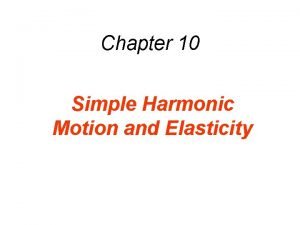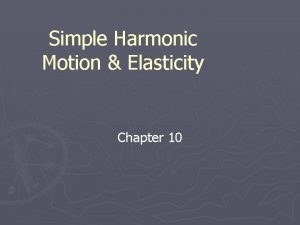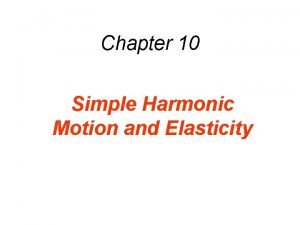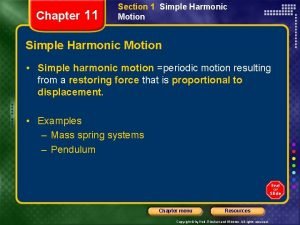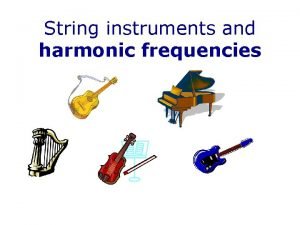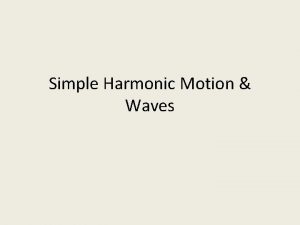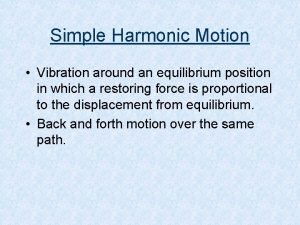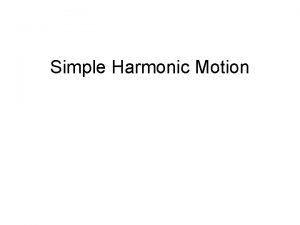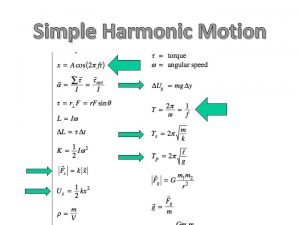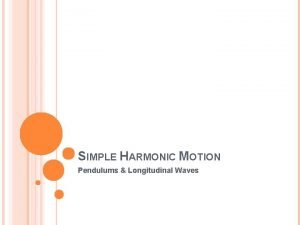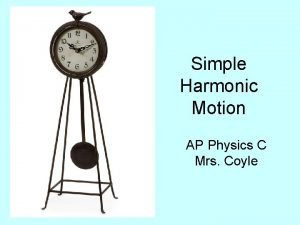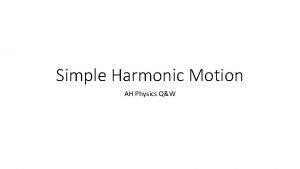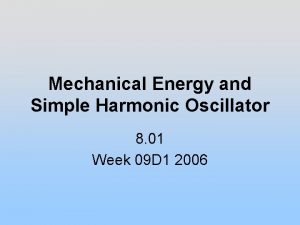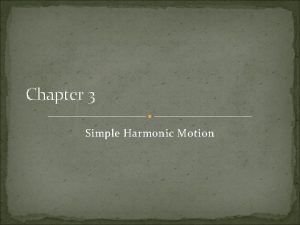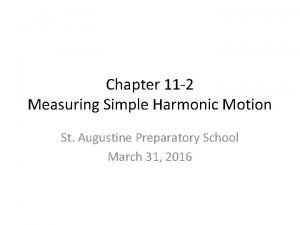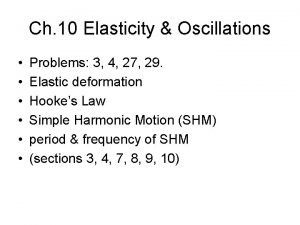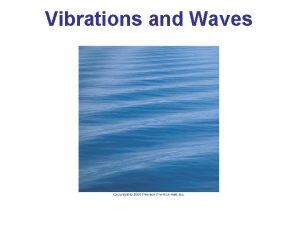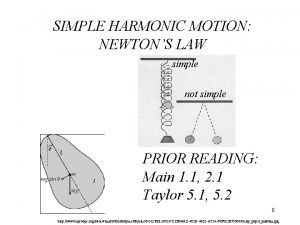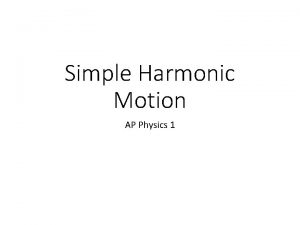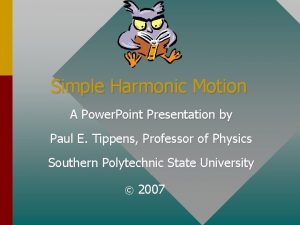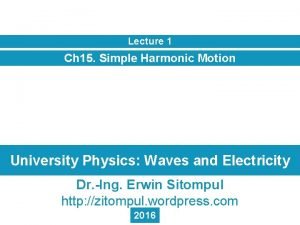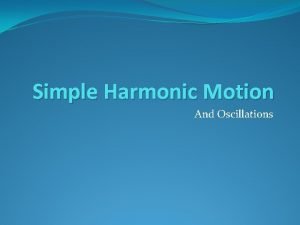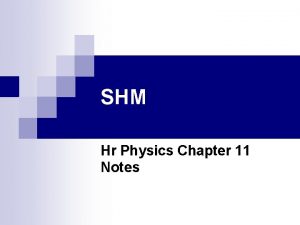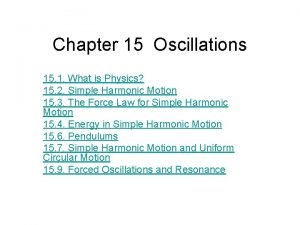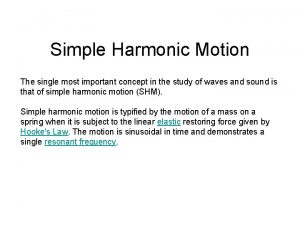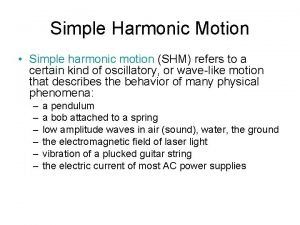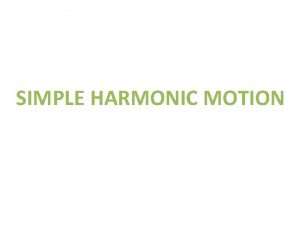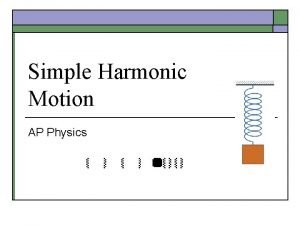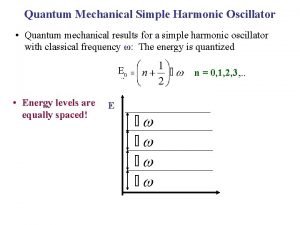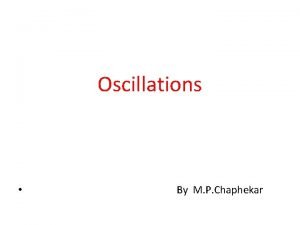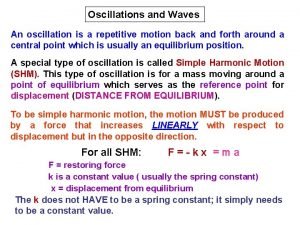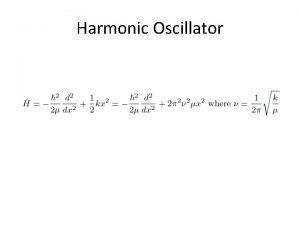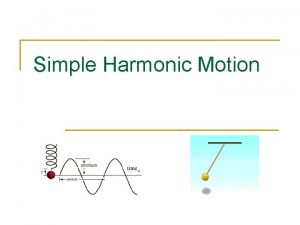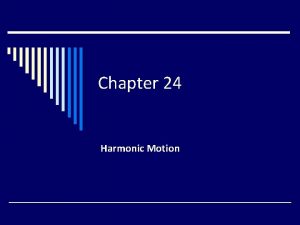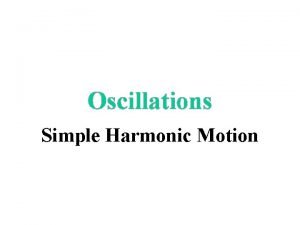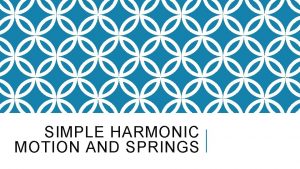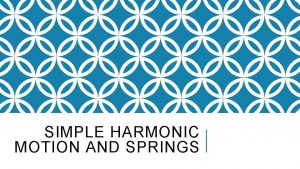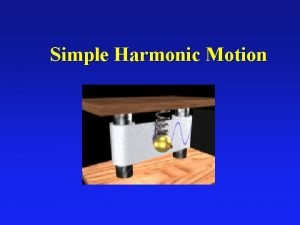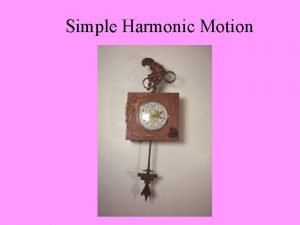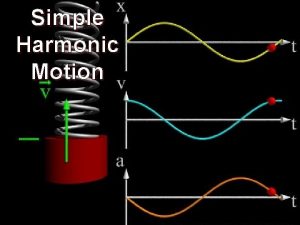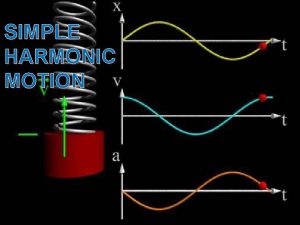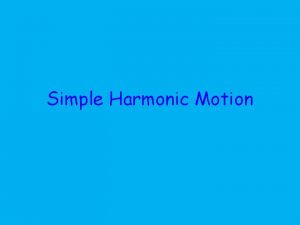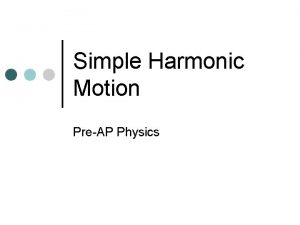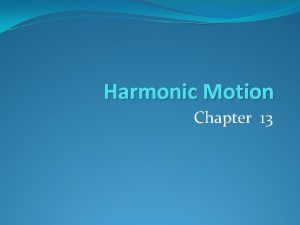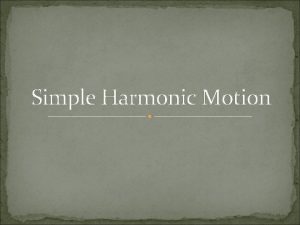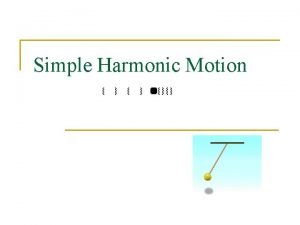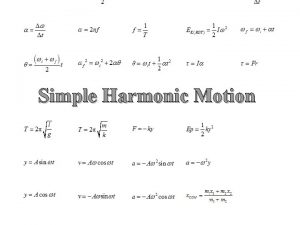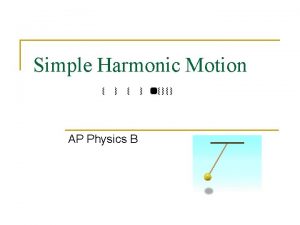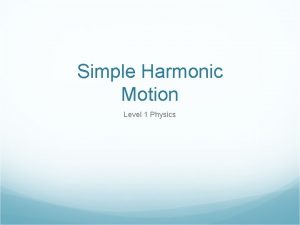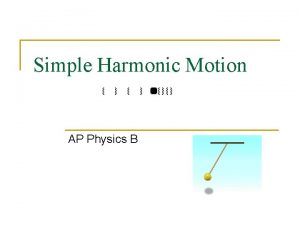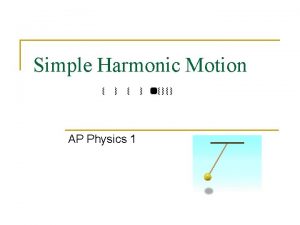Chapter 10 Simple Harmonic Motion and Elasticity 10







































- Slides: 39

Chapter 10 Simple Harmonic Motion and Elasticity

10. 1 The Ideal Spring and Simple Harmonic Motion spring constant Units: N/m

10. 1 The Ideal Spring and Simple Harmonic Motion Example 1 A Tire Pressure Gauge The spring constant of the spring is 320 N/m and the bar indicator extends 2. 0 cm. What force does the air in the tire apply to the spring?

10. 1 The Ideal Spring and Simple Harmonic Motion

10. 1 The Ideal Spring and Simple Harmonic Motion HOOKE’S LAW: RESTORING FORCE OF AN IDEAL SPRING The restoring force on an ideal spring is

10. 2 Simple Harmonic Motion and the Reference Circle DISPLACEMENT

10. 2 Simple Harmonic Motion and the Reference Circle

10. 2 Simple Harmonic Motion and the Reference Circle amplitude A: the maximum displacement period T: the time required to complete one cycle frequency f: the number of cycles per second (measured in Hz)

10. 2 Simple Harmonic Motion and the Reference Circle VELOCITY

10. 2 Simple Harmonic Motion and the Reference Circle Example 3 The Maximum Speed of a Loudspeaker Diaphragm The frequency of motion is 1. 0 KHz and the amplitude is 0. 20 mm. (a) What is the maximum speed of the diaphragm? (b) Where in the motion does this maximum speed occur?

10. 2 Simple Harmonic Motion and the Reference Circle (a) (b) The maximum speed occurs midway between the ends of its motion.

10. 2 Simple Harmonic Motion and the Reference Circle ACCELERATION

10. 2 Simple Harmonic Motion and the Reference Circle FREQUENCY OF VIBRATION

10. 2 Simple Harmonic Motion and the Reference Circle Example 6 A Body Mass Measurement Device The device consists of a spring-mounted chair in which the astronaut sits. The spring has a spring constant of 606 N/m and the mass of the chair is 12. 0 kg. The measured period is 2. 41 s. Find the mass of the astronaut.

10. 2 Simple Harmonic Motion and the Reference Circle

10. 3 Energy and Simple Harmonic Motion A compressed spring can do work.

10. 3 Energy and Simple Harmonic Motion

10. 3 Energy and Simple Harmonic Motion DEFINITION OF ELASTIC POTENTIAL ENERGY The elastic potential energy is the energy that a spring has by virtue of being stretched or compressed. For an ideal spring, the elastic potential energy is SI Unit of Elastic Potential Energy: joule (J)

10. 3 Energy and Simple Harmonic Motion Example 8 Changing the Mass of a Simple Harmonic Oscilator A 0. 20 -kg ball is attached to a vertical spring. The spring constant is 28 N/m. When released from rest, how far does the ball fall before being brought to a momentary stop by the spring?

10. 3 Energy and Simple Harmonic Motion

10. 4 The Pendulum A simple pendulum consists of a particle attached to a frictionless pivot by a cable of negligible mass.

10. 4 The Pendulum Example 10 Keeping Time Determine the length of a simple pendulum that will swing back and forth in simple harmonic motion with a period of 1. 00 s.

10. 5 Damped Harmonic Motion In simple harmonic motion, an object oscillated with a constant amplitude. In reality, friction or some other energy dissipating mechanism is always present and the amplitude decreases as time passes. This is referred to as damped harmonic motion.

10. 5 Damped Harmonic Motion 1) simple harmonic motion 2&3) underdamped 4) critically damped 5) overdamped

10. 6 Driven Harmonic Motion and Resonance When a force is applied to an oscillating system at all times, the result is driven harmonic motion. Here, the driving force has the same frequency as the spring system and always points in the direction of the object’s velocity.

10. 6 Driven Harmonic Motion and Resonance RESONANCE Resonance is the condition in which a time-dependent force can transmit large amounts of energy to an oscillating object, leading to a large amplitude motion. Resonance occurs when the frequency of the force matches a natural frequency at which the object will oscillate.

10. 7 Elastic Deformation Because of these atomic-level “springs”, a material tends to return to its initial shape once forces have been removed. ATOMS FORCES

10. 7 Elastic Deformation STRETCHING, COMPRESSION, AND YOUNG’S MODULUS Young’s modulus has the units of pressure: N/m 2

10. 7 Elastic Deformation

10. 7 Elastic Deformation Example 12 Bone Compression In a circus act, a performer supports the combined weight (1080 N) of a number of colleagues. Each thighbone of this performer has a length of 0. 55 m and an effective cross sectional area of 7. 7× 10 -4 m 2. Determine the amount that each thighbone compresses under the extra weight.

10. 7 Elastic Deformation

10. 7 Elastic Deformation SHEAR DEFORMATION AND THE SHEAR MODULUS The shear modulus has the units of pressure: N/m 2

10. 7 Elastic Deformation

10. 7 Elastic Deformation Example 14 J-E-L-L-O You push tangentially across the top surface with a force of 0. 45 N. The top surface moves a distance of 6. 0 mm relative to the bottom surface. What is the shear modulus of Jell-O?

10. 7 Elastic Deformation

10. 7 Elastic Deformation VOLUME DEFORMATION AND THE BULK MODULUS The Bulk modulus has the units of pressure: N/m 2

10. 7 Elastic Deformation

10. 8 Stress, Strain, and Hooke’s Law In general the quantity F/A is called the stress. The change in the quantity divided by that quantity is called the strain: HOOKE’S LAW FOR STRESS AND STRAIN Stress is directly proportional to strain. Strain is a unitless quantitiy. SI Unit of Stress: N/m 2

10. 8 Stress, Strain, and Hooke’s Law
 Simple harmonic motion and elasticity
Simple harmonic motion and elasticity Simple harmonic motion and elasticity
Simple harmonic motion and elasticity Oscillation
Oscillation Shm formula
Shm formula Simple harmonic motion chapter 11
Simple harmonic motion chapter 11 Tension wave
Tension wave Simple harmonic motion vocabulary
Simple harmonic motion vocabulary Simple harmonic motion equilibrium position
Simple harmonic motion equilibrium position Shm of a spring
Shm of a spring Reference circle shm
Reference circle shm Simple harmonic motion formula
Simple harmonic motion formula Harmonics equations
Harmonics equations Period of simple harmonic motion
Period of simple harmonic motion Frequency of damped oscillation
Frequency of damped oscillation Simple harmonic motion formula
Simple harmonic motion formula Simple harmonic motion formula
Simple harmonic motion formula A 125 n object vibrates
A 125 n object vibrates Frequency of shm
Frequency of shm Simple harmonic motion formula
Simple harmonic motion formula Simple harmonic motion formula
Simple harmonic motion formula Shm ap physics 1
Shm ap physics 1 Simple harmonic motion presentation
Simple harmonic motion presentation What is angular frequency in shm
What is angular frequency in shm Kinematics of simple harmonic motion
Kinematics of simple harmonic motion A trapeze artist swings in simple harmonic
A trapeze artist swings in simple harmonic Maximum excursion from equilibrium
Maximum excursion from equilibrium What is simple harmonic motion
What is simple harmonic motion Simple harmonic motion energy equation
Simple harmonic motion energy equation Frequency of shm formula
Frequency of shm formula Simple harmonic motion definition
Simple harmonic motion definition Simple harmonic motion
Simple harmonic motion Zero point energy formula
Zero point energy formula Damped oscillation
Damped oscillation Simple harmonic motion
Simple harmonic motion Simple harmonic motion lecture
Simple harmonic motion lecture Are jumping jacks harmonic motion
Are jumping jacks harmonic motion Chapter 2 section 1 describing motion answer key
Chapter 2 section 1 describing motion answer key Measuring motion
Measuring motion Section 1 describing motion answer key
Section 1 describing motion answer key Selection rules for harmonic oscillator
Selection rules for harmonic oscillator
